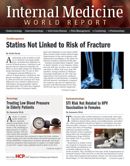Publication
Article
Internal Medicine World Report
Screening and Surveillance for Barrett's Esophagus: The Controversy Continues
Author(s):
Although the prevalence of Barrett's esophagus is considered moderate, the condition is the only established precursor of esophageal adenocarcinoma, and thus it has become the focus of programs of endoscopic screening and surveillance.

Although the prevalence of Barrett esophagus is considered moderate, the condition is the only established precursor of esophageal adenocarcinoma, and thus it has become the focus of programs of endoscopic screening and surveillance.
Population-based screening for Barrett esophagus has been, and remains, a controversial issue, in large part because it has not been shown that surveillance reduces the risk of death from esophageal adenocarcinoma.
In JAMA Internal Medicine (February 2015), Paul Lochhead, MBChB, MRCP, and Andrew Chan, MD, MPH, maintained that until research can show surveillance reduced the incidence and mortality of esophageal cancer and resolve the many controversies surrounding Barrett esophagus, patients should be apprised of the limitations of the available evidence. Furthermore, they should be encouraged to make informed choices about whether to participate in Barrett esophagus screening or surveillance programs.
Nonetheless, several organizations, including the American Gastroenterological Association (AGA), recommend routine endoscopic surveillance for individuals with Barrett esophagus, reasoning that if early invasive carcinoma can be identified, the patients may be offered potentially curative resection. And if dysplasia is found, the patient may be offered treatment that prevents further progression to invasive carcinoma.
The fact that Barrett esophagus progresses into esophageal adenocarcinoma in only a minority of cases is countered by the significant morbidity and poor survival rate associated with esophageal adenocarcinoma (5-year survival rate <20%). Additionally, the incidence of esophageal adenocarcinoma in the United States has risen markedly since 1975.
Lochhead and Chan highlight that even if endoscopy is found to be efficacious, it is expensive and requires an invasive procedure. A 2014 study using data from large population-based studies suggested that surveillance of patients with nondysplastic Barrett esophagus is unlikely to be cost-effective.
Fewer than 10% of patients with esophageal adenocarcinoma have a preceding diagnosis of Barrett esophagus, so surveillance of patients with Barrett esophagus alone is unlikely to have a major effect on overall esophageal adenocarcinoma incidence or mortality.
The AGA recommends screening for Barrett esophagus in those older than 50 years with symptomatic gastroesophageal reflux disease (GERD) and at least 1 additional risk factor for esophageal adenocarcinoma. But up to 20% of people in Western nations experience GERD symptoms, so the potential target population for screening is huge. Also, about 40% of people with esophageal adenocarcinoma do not report symptoms of GERD; thus screening based primarily on the presence of symptoms is likely to miss a substantial proportion of those at risk.
Lochhead and Chan concluded that physicians will continue to be concerned about adequate surveillance and screening for Barrett esophagus because of the poor survival rates associated with esophageal cancer as well as liability claims for “failure to screen for esophageal cancer in patients without alarm features.”






